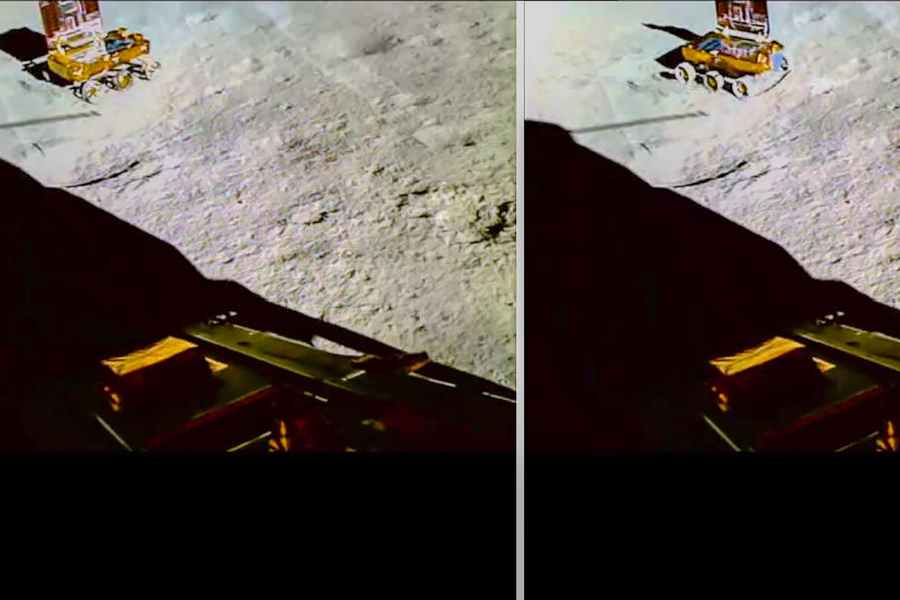
Pragyan Rover's rotation for a safe route on the surface of the Moon being captured by a Lander Image Camera aboard Vikram Lander as part of ISRO's Chandrayaan-3 lunar mission. Photo: ISRO.
BENGALURU (PTI): The initial assessment of the first-ever measurements of the near-surface lunar plasma environment over the south pole region by RAMBHA-LP payload onboard Chandrayaan-3 lander indicates that plasma there is relatively sparse, ISRO said on Thursday.
Meanwhile, the ILSA payload on Chandrayaan 3 lander to study lunar seismic activity has not only recorded the movements of rover and other payloads, but also has recorded an event, appearing to be a natural one, on August 26.
"The source of this event is under investigation," ISRO said.
"Radio Anatomy of Moon Bound Hypersensitive Ionosphere and Atmosphere - Langmuir Probe (RAMBHA-LP) payload onboard Chandrayaan-3 Lander has made first-ever measurements of the near-surface Lunar plasma environment over the south polar region. The initial assessment indicates that the plasma near the lunar surface is relatively sparse," ISRO said in a social media post.
These quantitative measurements potentially assist in mitigating the noise that Lunar plasma introduces into radio wave communication. Also, they could contribute to the enhanced designs for upcoming lunar visitors, ISRO said.
ISRO also released a video of the Chandrayaan-3 rover rotating in search of a safe route. The rotation was captured by a Lander Imager Camera.
"It feels as though a child is playfully frolicking in the yards of Chandamama, while the mother watches affectionately. Isn't it?", the ISRO social media post read.
Another instrument onboard the rover 'Pragyan' has confirmed the presence of Sulphur (S) in the Lunar region, through a different technique, ISRO said.
The Alpha Particle X-ray Spectroscope (APXS) has detected S, as well as other minor elements.
"This finding by Ch-3 compels scientists to develop fresh explanations for the source of Sulphur (S) in the area: intrinsic?, volcanic?, meteoritic?....?", read the post.
ISRO released a video showing an automated hinge mechanism rotating the 18 cm tall APXS, aligning the detector head to be approximately 5 cm in proximity to the lunar surface.
What are lunar soil and rocks made of in the south polar region where Chandrayaan-3 landed? How's it different from other highland regions? These are the questions that the 26-kg, six-wheeled, solar-powered rover is trying to find answers with its scientific instruments.
APXS instrument is best suited for in-situ analysis of the elemental composition of soil and rocks on the surface of planetary bodies having little atmosphere, such as the Moon, an ISRO statement said.
It carries radioactive sources that emit alpha particles and X-rays onto the surface sample. The atoms present in the sample in turn emit characteristic X-ray lines corresponding to the elements present. By measuring the energies and intensities of these characteristic X-rays, researchers can find the elements present and their abundances.
APXS observations have discovered the presence of interesting minor elements, including Sulfur, apart from the major expected elements such as Aluminum, Silicon, Calcium and Iron.
The Laser Induced Breakdown Spectroscope (LIBS) instrument onboard the rover has already confirmed the presence of Sulphur. Detailed scientific analysis of these observations are in progress.
 Previous Article
Previous Article Next Article
Next Article













The Indian Air Force, in its flight trials evaluation report submitted before the Defence Ministry l..
view articleAn insight into the Medium Multi-Role Combat Aircraft competition...
view articleSky enthusiasts can now spot the International Space Station (ISS) commanded by Indian-American astr..
view article